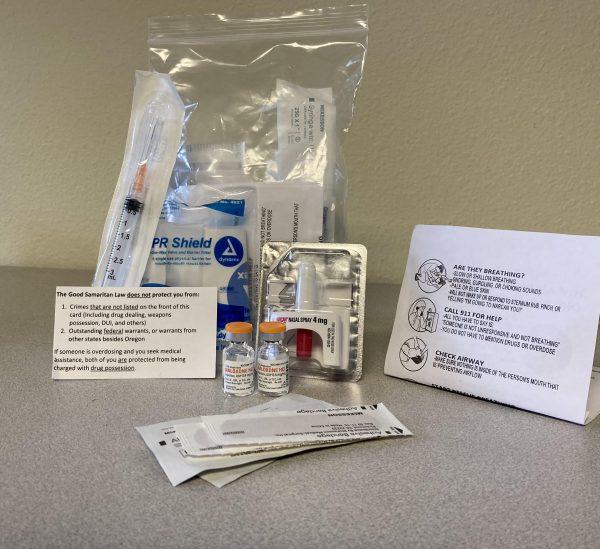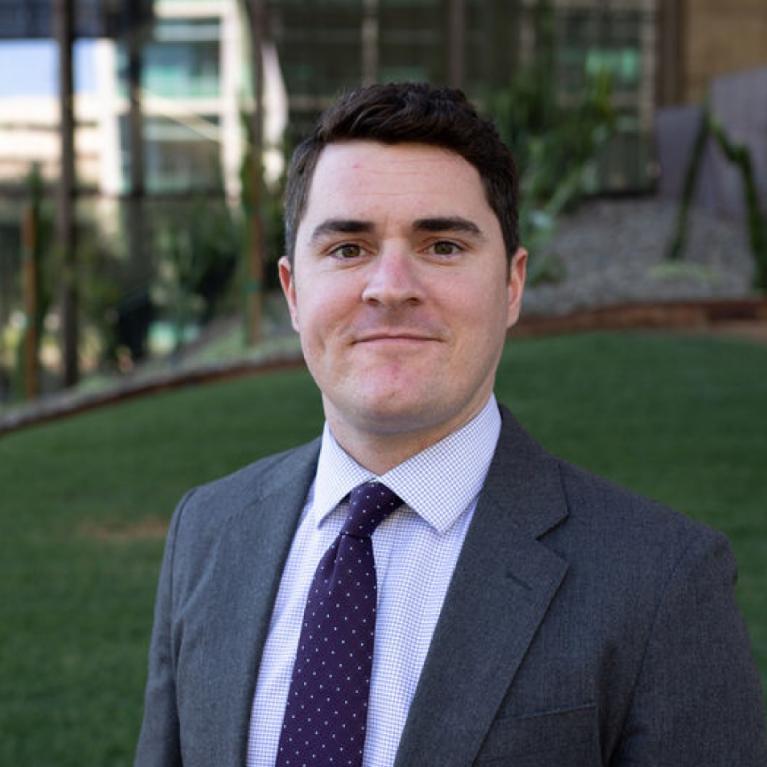A spike in fentanyl-related overdoses across Lane County has sparked concern over a lack of harm reduction supplies on the University of Oregon campus.
Fentanyl, a synthetic opioid often used to treat patients after surgery, has been co-opted by drug cartels to increase the potency of street drugs. It’s cheap, it’s plentiful and it’s the cause of tens of thousands of deaths each year in the United States.
According to the United States Drug Enforcement Administration, it can take only two milligrams of fentanyl to kill a person. That minuscule amount can easily hide in a five-milligram oxycodone pill or some lines of cocaine sitting on a coffee table at a party.
So when the Eugene Police Department announced a significant increase in fentanyl-related overdoses on April 25, the Eugene community was put on high alert.
“Based on what is being seen in our community, if someone buys a street or ‘party’ drug it should be assumed it contains fentanyl,” the news release said. A party drug is a recreational drug like Xanax, oxycodone and cocaine — a drug EPD is especially concerned about since it’s received growing reports of powdered fentanyl.
Now out of the height of the pandemic, UO students are having more parties, which means more of these party drugs are likely in circulation.
However, harm reduction supplies like fentanyl testing strips and naloxone — which is also known as Narcan and is used to reverse an overdose — are not readily accessible for students.
Kayla Krueger, an ASUO senator and a sophomore, had been working on a project to bring fentanyl testing strips to the Erb Memorial Union since fall term. The strips work by making the drug into a powder, mixing it up, dissolving a small portion in water and placing the test strip in.

The contents of a testing package needed to check substances for fentanyl. ASUO member, Kayla Krueger, is working on making fentanyl testing strips accessible for the UO community. (Liam Sherry/Emerald)
She said she was working with the Women’s Center on a plan to buy the tests in bulk from a distributor selling them for 95 cents each. They would have been available in the EMU for students, sort of like the contraceptive stations near bathrooms in the building.
Krueger needed approval from UO to carry out her project. However, the UO General Council determined that providing fentanyl testing strips would be in violation of a state law against the sale of drug paraphernalia.
The law specifically identifies “testing equipment marketed for use or designed for use in identifying or in analyzing the strength, effectiveness or purity of controlled substances” as being illegal.
“It was really shocking, especially because we had been working on the project for so long,” Krueger said.
She plans to lobby with other ASUO members and non-profits to change that state law next year.
She said she has spoken to people who have lost loved ones due to fentanyl overdoses. “I’d hate for anyone at the University of Oregon to go through something like that.”
In 2020, a UO student unknowingly purchased fentanyl-laced oxycodone pills, which resulted in his death. According to a news release from the Department of Justice, a Eugene resident was recently sentenced to federal prison for selling the student the laced drug.
Dean Shold, a co-founder of a non-profit called FentCheck that aims to supply businesses, organizations and schools with fentanyl testing strips, said he was interested in working with UO to provide fentanyl testing strips to students. FentCheck, which works with over 50 venues, currently collaborates with UC Berkeley to distribute testing strips through Berkley’s University Health Services.
“You will always hear this expression ‘harm reduction is meeting people where they’re at,’” he said. “Some of them are at syringe exchanges, but those aren’t the ones we’re looking at. It’s the recreational drug users, the kids who are going into university and want to experiment.”
However, Shold said he was not aware of the university’s hesitancy with fentanyl testing strips until ASUO attempted its initiative.
“There’s this huge stigma around checking your drugs,” he said. “If you’re checking it, ‘oh my gosh, that’s a bad thing.’ No, this is a good thing. This is how you actually can make informed consent decisions and stay alive.”
Becky Noad, HIV Alliance’s prevention and education manager, distributes hundreds of fentanyl testing strips around the Eugene area and said she has never heard of this law. “I wouldn’t classify them as drug paraphernalia,” she said.
During the fiscal year of 2020 to 2021, HIV Alliance distributed fentanyl testing strips to about 425 clients, according to Noad. Over 100 of those clients reported the presence of fentanyl in their drugs.
“Fentanyl is very much present in our community,” Noad said. “It’s contaminating a lot of drugs and just assume that the drugs that you’re getting probably do have fentanyl in them.”
 An injection Naloxone kit. This kit includes a dose of nasal Narcan, instructions on giving Narcan, a CPR face shield, syringes, two doses of injection Naloxone and an information card about Oregon’s Good Samaritan Law. (Courtesy of Rebecca Noad and HIV Alliance)
An injection Naloxone kit. This kit includes a dose of nasal Narcan, instructions on giving Narcan, a CPR face shield, syringes, two doses of injection Naloxone and an information card about Oregon’s Good Samaritan Law. (Courtesy of Rebecca Noad and HIV Alliance)
Jason Davis of Lane County Public Health said all of Lane County is experiencing a spike right now, but fentanyl has always been a problem. He said the county receives about 10 emergency calls related to fentanyl overdoses per week.
Spikes occur because certain batches of drugs that come into the market contain fentanyl, he said. Once the supply runs out or a drug bust happens, overdoses will start to drop off.
In the latest example of local batches being halted, EPD announced on May 19 that it found approximately 11,000 suspected fentanyl pills in a Eugene residence. Davis said adding fentanyl to pills is a cheaper solution for sellers to make their drugs more potent.
Fentanyl creeping into the party drug circulation is especially alarming to Davis. He said people doing party drugs usually don’t have the tolerance for opioids that regular users do, meaning they’re more susceptible to overdoses.
“They’re doing it on weekends. They’re doing it at parties. Maybe once a month. Now those folks are at risk,” he said.
Despite the recent spike, Davis said, Narcan, a nasal spray that can reverse the effects of an overdose, has prompted historic lows in Lane County for overdose deaths.
Erik Kilgore, who runs a non-profit called Henry’s Uncle that centers on ending the stigma of addiction and raising awareness about illicit fentanyl, and Nathan Smiddy, a member of the non-profit A New PATH with a similar mission to Henry’s Uncle, handed out free Narcan and held trainings on how to use it at the ASUO Street Faire.

Kilgore started Henry’s Uncle after his brother, a former UO student, passed away from a fentanyl-related overdose in 2018.
“Many students would stop dead in their tracks when they heard Narcan or free Narcan,” he said. “They know about the fentanyl epidemic, and they want to be a part of the solution. They want to be prepared in case.”
Smiddy said he overdosed at age 19, and Narcan saved his life. He said he distributes Narcan and spreads awareness because he wants to prevent unnecessary death and help others avoid his lived experiences.
According to Smiddy, they trained 265 people and distributed 530 doses of Narcan.
“We had parents literally turning their son around to watch the training and grab a kit to make sure, you know, because it can happen anywhere anytime,” Kilgore said. “It turned out the father was an EMT and knew the importance of having Narcan on hand.”
Students told Kilgore they wanted Narcan, but it’s often too expensive for them, he said.
“The most common response was ‘We know what it is. We don’t know how to use it, and it’s also not easily accessible,’” he said.
In Oregon, pharmacists can dispense Narcan without a prescription. Hirons, which has some of the closest pharmacies to the UO campus, said it sells Narcan for $135 a box, which contains two doses.
Kilgore said that price is ridiculous because naloxone, the generic form of Narcan, is made cheaply. However, he said he isn’t shocked because Narcan is owned by the company Emergent BioSolutions and is the most common version of naloxone that is delivered nasally rather than via a syringe.
The average price of naloxone in the United States is $31 according to a 2020 study in the National Library of Medicine.
“It seems like Emergent is charging higher prices for Narcan because of their delivery mechanism, which is unethical, especially during a national epidemic,” Kilgore said.
One Resident Assistant spoke to Kilgore at the ASUO Street Faire and said they wished every dorm had nasal naloxone on hand in case someone begins to overdose, Kilgore said.
UO Communications Spokesperson Molly Blancett said Narcan is not available in the residence halls.
The Daily Emerald spoke to three RAs who said they were never trained on how to use naloxone. One RA said any time a resident needs medical assistance, they must call 9-1-1.
Kilgore said ambulances may not be able to reach students overdosing in time before brain damage can start.
According to a study published in the Journal of the American Medical Association, ambulances’ average response time is seven minutes. However, the National Library of Medicine said permanent brain damage can occur after four minutes without oxygen — a common way people die of overdoses.
Smiddy and Kilgore want to work with Krueger to lobby the state legislature to change the law preventing the distribution of fentanyl testing strips.
“The thing with Narcan is that it’s something that they’d use after the fact,” Krueger said. “That’s something that someone has to have on hand if someone goes into an overdose. I think it would be a lot more effective to just prevent all that.”
Shold, whose non-profit mostly operated in California, lobbied for state Assembly Bill 1598, which excludes fentanyl testing equipment from state law similar to Oregon’s law banning drug paraphernalia. The law passed the Assembly on March 17 and was ordered to the Senate.
He said he hopes to help lobby for a similar bill here as well.
“If we were to be able to change the law, it would mean that I’m doing my part to help people my age and help save some lives,” Krueger said. “It would be really powerful just to provide that sort of basic necessity and safety precaution.”







